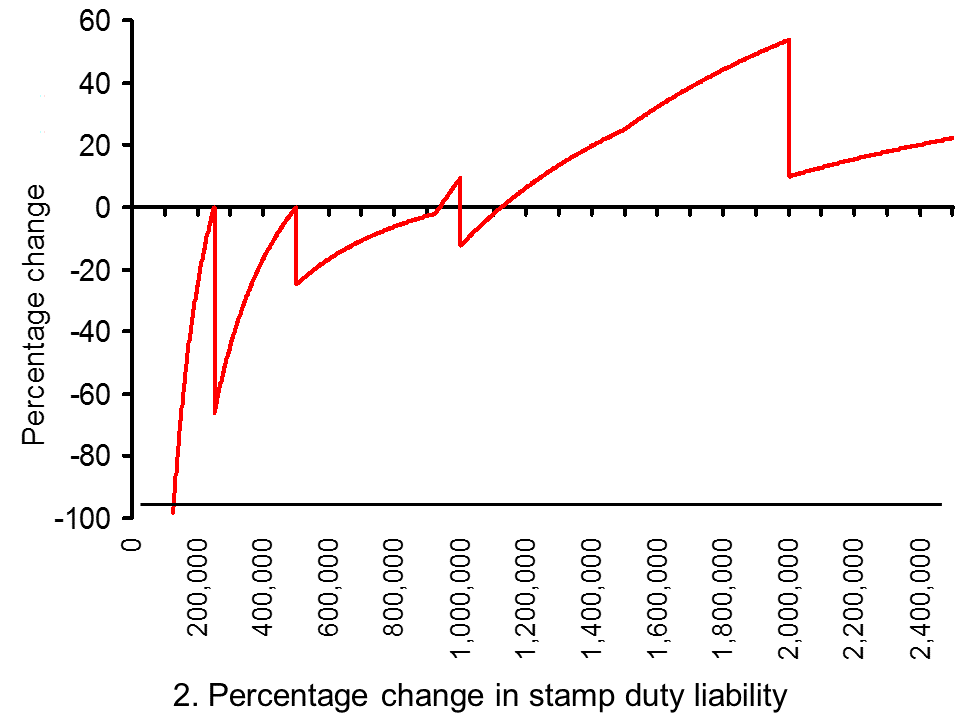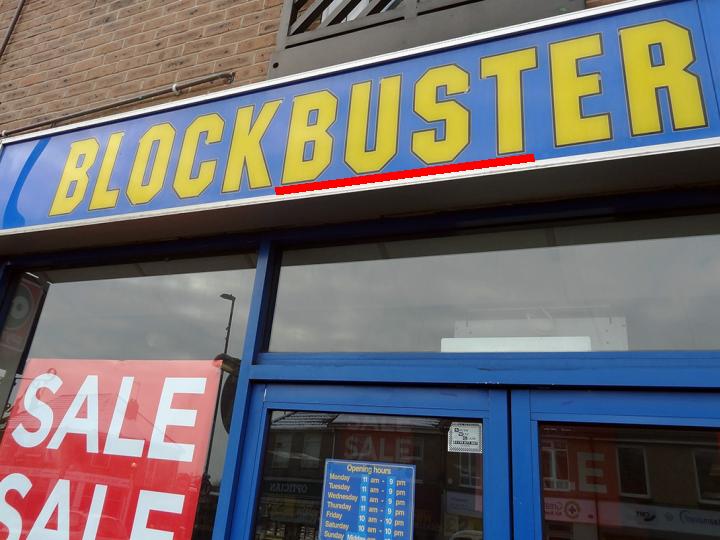 As we reported in New Build: Foundations for a successful housing policy? the Autumn Statement heralded significant reforms to Stamp Duty – the UK tax on house purchases. The result is the introduction of a graduated system of tax, along the lines of the income tax system. A similar regime will continue to operate in Scotland when the Land and Buildings Transactions Tax replaces Stamp Duty next April. Here we consider the impact on the effective rates of tax following the changes to Stamp Duty.
As we reported in New Build: Foundations for a successful housing policy? the Autumn Statement heralded significant reforms to Stamp Duty – the UK tax on house purchases. The result is the introduction of a graduated system of tax, along the lines of the income tax system. A similar regime will continue to operate in Scotland when the Land and Buildings Transactions Tax replaces Stamp Duty next April. Here we consider the impact on the effective rates of tax following the changes to Stamp Duty.
Under the old system any house purchase involving a property whose value was £125,000 or less incurred no Stamp Duty liability. Thereafter, one of five tax rates applied: 1% above £125,000 to £250,000, 3% above £250,000 to £500,000, 4% above £500,000 to £1m, 5% above £1m to £2m and 7 per cent for properties over £2m. The important point was that the whole of the purchase price was subject to one of these five progressively higher tax rates.
The new system sees the introduction of a graduated system of tax which means that the amount paid by house purchasers will be dependent upon the proportion of the value of the property that falls in each of the tax bands. Again, for properties up to £125,000 there will be no liability. There will then be four bands: 1% above £125,000 to £250,000, 5% above £250,000 up to £925,000, 10% above £925,000 up to £150,000 and 12% above £150,000.
One significant impact of the changes is that the liability will be more proportionate to the value of the property. To see this we can compare the average rate of tax under the new and old tax system. The average rate of tax is simply the amount of the tax liability relative to the price of the property.
 From Chart 1 we can see how the new average rate of tax under rises progressively with the price of the property. (Click here to download a PowerPoint of the chart). Under the old system, the profile of the average rate of tax looks like a series of steps with a slab at each tax rate. Unsurprisingly, the system was sometimes referred as the ‘slab system’.
From Chart 1 we can see how the new average rate of tax under rises progressively with the price of the property. (Click here to download a PowerPoint of the chart). Under the old system, the profile of the average rate of tax looks like a series of steps with a slab at each tax rate. Unsurprisingly, the system was sometimes referred as the ‘slab system’.
A second significant change will be the removal of the significant spikes in the marginal rate of tax around each of the tax bands. For example, the tax liability on a property costing £125,001 was £1,250.01 compared with a zero liability on a property costing £125,000. Therefore, a £1 rise in the price of property was accompanied by a £1,250.01 rise in the purchase tax. In percentage terms this is a marginal rate of tax of 125,001. Chart 1 shows how the marginal rates now match the progressively higher tax rates that become payable between each threshold.
The principle of removing the significant distortions to pricing created by the old system of Stamp Duty is likely to receive general approval. However, there may be some unease around the short-term implications for house prices of the bands and rates under the new system. This is largely because nobody purchasing a property at £937,000 or less will see their tax liability rise. The reduction in the liability raises concerns about a potential boost to house prices.
 Chart 2 show the percentage change in the Stamp Duty liability for properties of up to £2.5 million. (Click here to download a PowerPoint of the chart.) The average UK house price, excluding London, is currently £235,000. The stamp duty saving in this case is £150 or 6.4 per cent.
Chart 2 show the percentage change in the Stamp Duty liability for properties of up to £2.5 million. (Click here to download a PowerPoint of the chart.) The average UK house price, excluding London, is currently £235,000. The stamp duty saving in this case is £150 or 6.4 per cent.
But there are more significant savings than this from the reforms, including in London where inflationary pressures in the housing market have been more significant. Here annual price inflation ran at close to 20 per cent in the second and third quarters of the year. Given that the average house price in London is currently £510,000, this means a Stamp Duty saving of £4,900 or 24 per cent. Of course, for premium London markets (and other similar markets elsewhere) a quite different effect could arise. The liability on a £2m property rises by 53.75 per cent. Nonetheless, for most markets it is the boost to prices that is most concerning.
In the East Midlands, which is a good barometer of the market in the rest of the country, there will be a saving of £610 or 32 per cent on the current average property purchase of £189,000. Therefore, even in markets where house price inflation is more subdued there is the potential that the changes to the Stamp Duty system will, in the short term at least, boost housing demand and fuel house price growth.
Stamp Duty/Land and Buildings Transactions Tax
Rates and allowances: Stamp Duty Land Tax Gov.UKLand and Buildings Transaction Tax Revenue Scotland
Autumn Statement
Autumn Statement: documents Gov.UK
Articles
The home owners cashing in on stamp duty reforms Telegraph, Dan Hyde (2/12/14)
Christmas comes early for estate agents after stamp duty changes Guardian, Nigel Bunyan (7/12/14)
Stamp duty: House price boom and mansion bust Telegraph, Anna White (6/12/14)
£200m house deal stampede by wealthy to beat stamp duty hike: Reforms spark one of busiest periods for estate agents in 25 years Daily Mail Online, Louise Eccles and Ruth Lythe (5/12/14)
Stamp duty changes boost housing market and push up prices Guardian, Hilary Osborne (5/12/14)
Stamp Duty revamp blow to SNP property tax reforms Scotsman, Tom Peterkin and Jane Bradley (4/12/14)
 Autumn Statement: What do stamp duty changes mean? BBC News, (3/12/14)
Autumn Statement: What do stamp duty changes mean? BBC News, (3/12/14)
Data
House Price Indices: Data Tables Office for National Statistics
Questions
- What is the tax base of Stamp Duty and the Land and Buildings Transaction Tax?
- How does Stamp Duty distort choices?
- Under the old Stamp Duty system, why might a seller be reluctant to put their property on the market at £251,000?
- What is meant by the average and marginal rates of tax?
- What is meant by a progressive tax?
- What is the connection between the average rate of tax and how progressive a tax is?
- Calculate the marginal rates of tax (in percentage terms) under the old Stamp Duty system following a £1 rise which results in a property’s value moving into the next tax band (start with a £1 rise from £125,000 to £125,001).
- Using a demand-supply diagram show the effect of the Stamp Duty reforms on house prices in most UK housing markets. What characteristics of supply would make the change in price particularly large?
- Are there any housing markets where demand could fall following the introduction of the reforms to Stamp Duty? Illustrate the possible effects using a demand-supply diagram.
- How might an economist go about evaluating the Stamp Duty reforms? What factors will affect the judgement formed?
 The typical UK high street is changing. Some analysts have been arguing for some time that high streets are dying, with shops unable to face the competition from large supermarkets and out-of-town malls. But it’s not all bad news for the high street: while some types of shop are disappearing, others are growing in number.
The typical UK high street is changing. Some analysts have been arguing for some time that high streets are dying, with shops unable to face the competition from large supermarkets and out-of-town malls. But it’s not all bad news for the high street: while some types of shop are disappearing, others are growing in number.
Part of the reason for this is the rise in online shopping; part is the longer-term effects of the recession. One consequence of this has been a shift in demand from large supermarkets (see the blog, Supermarket wars: a pricing race to the bottom). Many people are using local shops more, especially the deep discounters, but also the convenience stores of the big supermarket chains, such as Tesco Express and Sainsbury’s Local. Increasingly such stores are opening in shops and pubs that have closed down. As The Guardian article states:
The major supermarket chains are racing to open high street outlets as shoppers move away from the big weekly trek to out-of-town supermarkets to buying little, local and often.

Some types of shop are disappearing, such as video rental stores, photographic stores and travel agents. But other types of businesses are on the increase. In addition to convenience stores, these include cafés, coffee shops, bars, restaurants and takeaways; betting shops, gyms, hairdressers, phone shops and tattoo parlours. It seems that people are increasingly seeing their high streets as social places.
Then, reflecting the widening gap between rich and poor and the general desire of people to make their money go further, there has been a phenomenal rise in charity shops and discount stores, such as Poundland and Poundworld.

So what is the explanation? Part of it is a change in tastes and fashions, often reflecting changes in technology, such as the rise in the Internet, digital media, digital photography and smart phones. Part of it is a reflection of changes in incomes and income distribution. Part of it is a rise in highly competitive businesses, which challenge the previous incumbents.
But despite the health of some high streets, many others continue to struggle and the total number of high street stores across the UK is still declining.
What is clear is that the high street is likely to see many more changes. Some may die altogether, but others are likely to thrive if new businesses are sufficiently attracted to them or existing ones adapt to the changing market.
How the rise of tattoo parlours shows changing face of Britain’s high streets The Guardian, Zoe Wood and Sarah Butler (7/10/14)
The changing face of the British High Street: Tattoo parlours and convenience stores up, but video rental shops and travel agents down Mail Online, Dan Bloom (8/10/14)
High Street footfall struggles in August Fresh Business Thinking, Jonathan Davies (15/9/14)
Ghost town Britain: Internet shopping boom sees 16 high street stores close every day Mail Online, Sean Poulter (8/10/14)
Questions
- Which of the types of high street store are likely to have a high income elasticity of demand? How will this affect their future?
- What factors other than the types of shops and other businesses affect the viability of high streets?
- What advice would you give your local council if it was keen for high streets in its area to thrive?
- Why are many large superstores suffering a decline in sales? Are these causes likely to be temporary or long term?
- How are technological developments affecting high street sales?
- What significant changes in tastes/fashions are affecting the high street?
- Are you optimistic or pessimistic about the future of high streets? Explain.
 The Scottish debate revolved around a variety of issues and one of the key factors that added weight to the ‘No’ campaign was the idea of being British. But the concept of ‘Britishness’ is not just important to those who live here. It still appears to be a key signal of quality in foreign markets and it is something which foreign consumers are willing to pay a price for.
The Scottish debate revolved around a variety of issues and one of the key factors that added weight to the ‘No’ campaign was the idea of being British. But the concept of ‘Britishness’ is not just important to those who live here. It still appears to be a key signal of quality in foreign markets and it is something which foreign consumers are willing to pay a price for.
Barclays Corporate Banking has undertaken research into eight key export markets to determine the value of ‘Britain’. One of the key factors that boost demand for a product is quality and another is the idea of a brand. As quality improves and brands become more recognized, a product’s demand curve will begin to shift to the right, thus pushing up the market price. In other words, with higher quality and brand recognition, an individual’s willingness to pay rises. One brand that foreign consumers seem willing to pay a premium to purchase are those labelled ‘Made in Britain’.
The research indicates that 31% of customers in emerging markets have been prepared to and have purchased products that are from Britain, despite the higher price. Seeing the label ‘Made in Britain’ seems to send the signal of quality and this in turn creates a higher willingness to pay. Furthermore, this willingness to pay, while still good for Scottish, English and Welsh products, is higher for ‘British’ products, perhaps another indication of the truth behind the ‘Better together’ campaign.
The increase in willingness to pay between products with seemingly no country of origin and a British country of origin is 7% and this knowledge should give a confidence boost to the British export market. It should also indicate to exporters in Wales, Scotland and England that they are better to advertise as ‘Made in Britain’ than ‘Made in Wales, Scotland or England’. The expected boost from the 8 key emerging markets is around £2bn. The following articles consider the concept of ‘Brand Britain’.
Good news for exports as Brand Britain is revealed to be valuable concept Small Business, John Bromley (3/11/14)
Britain ‘best brand’ for Welsh exports, survey suggests BBC News (26/11/11)
Overseas consumers 64% more willing to pay premium for ‘Brand Britain’ Marketing Week, Sebastian Joseph (3/11/14)
Report flags up ‘British’ benefit The Courier, James Williamson (3/10/14)
Questions
- Using a diagram, illustrate the effect of a product’s being a well-known brand on its equilibrium price and quantity.
- Why is it that the relative willingness to pay a premium for British products is higher in developing countries than in developed countries?
- Using the concept of marginal utility theory, explain the impact of the ‘Made in Britain’ label.
- The BBC News article suggests, however, that some Welsh companies have not found the brand effect to be the case. What factors might explain this?
- To what extent are the concepts of consumer and producer surplus relevant here?
 Merlin Entertainments PLC is one of the largest operator of visitor attractions in the world and owns over a third of the most popular theme parks in Europe. It runs the four most visited parks in England – Alton Towers, Legoland Windsor, Thorpe Park and Chessington World of Adventures as well as the most popular theme park in Italy – Gardaland. Alton Towers alone had 2.5 million visitors in 2013. Anybody thinking of going to one of these attractions is faced with a wide range of different entry fees .
Merlin Entertainments PLC is one of the largest operator of visitor attractions in the world and owns over a third of the most popular theme parks in Europe. It runs the four most visited parks in England – Alton Towers, Legoland Windsor, Thorpe Park and Chessington World of Adventures as well as the most popular theme park in Italy – Gardaland. Alton Towers alone had 2.5 million visitors in 2013. Anybody thinking of going to one of these attractions is faced with a wide range of different entry fees .
Theme parks and tourist attractions have market power so their owners have to make some interesting pricing decisions. They have to tackle the same dilemma that confronts any seller that faces a downward sloping demand curve for its goods/services.
One option for the firm would be to increase the entry fee. This would produce higher profits per visitor as some of the surplus from the transaction previously enjoyed by the consumer will be extracted by the seller and converted into producer surplus. Unfortunately for the business the higher price, all other things equal, will also result in fewer visitors. Some people will be deterred from visiting because of the higher price and the seller will lose out on potential revenue.
An alternative strategy would be for the theme park to reduce its entry fee. All other things equal, this will increase the number of visitors. However, it would also mean that the profit per customer would fall. The frustrating issue for the seller is that some of its customers, who would still have visited the attraction at the higher price, are now able to get a better deal.
This dilemma exists if the seller has to charge all of its different customers the same entry fee. If it could charge a higher entry fee to those customers who would be willing to pay more and a lower entry fee to those who would be willing to pay less then it could make more money. Extra revenue could be obtained from those additional sales that take place at the lower price while more consumer surplus could be extracted from those still paying the higher price.
Is it possible for a firm to charge different prices to different customers for the same or a similar good or service? Table 1 below shows the entry fees for Warwick Castle, another tourist attraction owned by Merlin Entertainments PLC.

It can immediately be seen from this table that some groups of customers pay a different entry fee from others. For example adults have to pay £24 to enter on the day while people aged 60 and over pay a lower price £16.80. The entry fee for children aged between 4 and 11 is £21.00 while those aged 3 and under go for free. Students aged 16-18 can gain entry for a price of £13.50 if they can provide valid ID and purchase the tickets from the visitbritainshop website.
In this example, the company has allocated people into different categories by age (i.e. senior, adult, student, older children and younger children) and has set the entry fee that customers in each group have to pay.

The table also shows that if customers purchase on- line then they can get the tickets more cheaply. The entry fee for each category is 25% lower if the ticket is booked seven days in advance i.e. the prices shown in the last column in the table. If the booking is made between 2-6 days in advance then the discount is only 10% i.e. an adult ticket would cost £21.60. The on-line discounts are open to everyone. People are given the choice to either book on-line in advance or pay on the day. This is different from a situation where you are placed into a category by the firm. For example the customer cannot choose whether they are over 60!
If people are prepared to spend more time searching on the internet then other cheaper prices can also be obtained. Once again these offers are open to anyone willing to spend the time and effort in order to find them.
All the ticket prices above give people access to exactly the same attractions on the day. They do not give the visitor access to two of the attractions at the castle – the Dragon Tower and Castle Dungeon. Entry to the Dragon Tower would cost an adult on the day an extra £1.80 while entry to the Castle Dungeon would cost an extra £5.40.
Warwick Castle Ticket Prices Warwick Castle (accessed on 04/09/14)
Alton Towers Alton Towers (accessed on 08/09/14)
Warwick Castle Tickets visitbritainshop (accessed on 02/09/14)
Global Attractions Attendance Report teaconnect (accessed on 05/09/14)
Merlin Entertainments Merlin Entertainments (accessed on 08/09/14)
Questions
- What pricing decisions do firms have to make if they operate in a perfectly competitive market?
- Explain why an individual tourist attraction will have a downward sloping demand curve
- Paying an entry fee and an extra payment per attraction is known as what type of pricing? What advantages does this type of price strategy have for the seller?
- How would you calculate the profit per customer? What factors other than the entrance fee would determine the profit made per customer in a theme park or tourist attractions?
- Paying a different price depending on which category you have been assigned to by the seller is known as what type of pricing strategy? Can this type of pricing strategy ever be in the interests of society?
- In the example used in the case, customers are assigned to different categories by age. Can you think of any other ways that firms could categorise their customers?
- Given the category customers have been assigned to they can pay different prices depending on whether they buy the tickets on line. What is the price strategy called when customers can choose from a variety of pricing options for the same or similar product? Can you think of any different methods that could be used by the seller to carry out this type of pricing strategy?
 Every year thousands of entrepreneurs will have another great idea that is sure to take off and bring in millions of customers. However, most of these great ideas will turn into another business failure. But, in the case of Dropbox, it is multiple business failures that eventually created a huge success, giving hope to millions of budding entrepreneurs.
Every year thousands of entrepreneurs will have another great idea that is sure to take off and bring in millions of customers. However, most of these great ideas will turn into another business failure. But, in the case of Dropbox, it is multiple business failures that eventually created a huge success, giving hope to millions of budding entrepreneurs.
With 300 million users, the file sharing ‘Dropbox’ is certainly a success, estimated at a value of $10bn. But it didn’t happen immediately and was preceded by a few failures. So, what is the secret to success in this case? The co-founder of Dropbox, Drew Houston, said that it is all about providing something that customers want. In the case of Dropbox, customers are crucial: the more people use it, the easier it becomes for others to use it too, as it allows file sharing on a much larger scale. Perhaps here we have a case of network externalities.
With Dropbox people would tell their friends about it and collaborate. So when you go into work and work on a project with colleagues you recruit them in essence to become Dropbox users because you’re all working on a project together.
No doubt there are many other examples of businesses that have proved a success after several failed attempts. Providing customers with what they want, at the time when they need it is clearly a key ingredient, but so, it appears, is business failure. The following article from BBC News considers the rise of Dropbox.
 Dropbox and the failures behind it BBC News, Richard Taylor (1/7/14)
Dropbox and the failures behind it BBC News, Richard Taylor (1/7/14)
Questions
- Customers are clearly crucial for any business to succeed. How can a new entrepreneur find out if there is a demand?
- Why was timing so important in the case of Dropbox?
- Given that customers can actually use Dropbox for free, how does this company make so much money?
- What are network externalities? Explain them in the context of Dropbox.
- Drew Houston says that ‘distribution’ is another key ingredient to success. What do you think is meant by this and how will it help create success?
 As we reported in New Build: Foundations for a successful housing policy? the Autumn Statement heralded significant reforms to Stamp Duty – the UK tax on house purchases. The result is the introduction of a graduated system of tax, along the lines of the income tax system. A similar regime will continue to operate in Scotland when the Land and Buildings Transactions Tax replaces Stamp Duty next April. Here we consider the impact on the effective rates of tax following the changes to Stamp Duty.
As we reported in New Build: Foundations for a successful housing policy? the Autumn Statement heralded significant reforms to Stamp Duty – the UK tax on house purchases. The result is the introduction of a graduated system of tax, along the lines of the income tax system. A similar regime will continue to operate in Scotland when the Land and Buildings Transactions Tax replaces Stamp Duty next April. Here we consider the impact on the effective rates of tax following the changes to Stamp Duty. From Chart 1 we can see how the new average rate of tax under rises progressively with the price of the property. (Click here to download a PowerPoint of the chart). Under the old system, the profile of the average rate of tax looks like a series of steps with a slab at each tax rate. Unsurprisingly, the system was sometimes referred as the ‘slab system’.
From Chart 1 we can see how the new average rate of tax under rises progressively with the price of the property. (Click here to download a PowerPoint of the chart). Under the old system, the profile of the average rate of tax looks like a series of steps with a slab at each tax rate. Unsurprisingly, the system was sometimes referred as the ‘slab system’.  Chart 2 show the percentage change in the Stamp Duty liability for properties of up to £2.5 million. (Click here to download a PowerPoint of the chart.) The average UK house price, excluding London, is currently £235,000. The stamp duty saving in this case is £150 or 6.4 per cent.
Chart 2 show the percentage change in the Stamp Duty liability for properties of up to £2.5 million. (Click here to download a PowerPoint of the chart.) The average UK house price, excluding London, is currently £235,000. The stamp duty saving in this case is £150 or 6.4 per cent.  Autumn Statement: What do stamp duty changes mean? BBC News, (3/12/14)
Autumn Statement: What do stamp duty changes mean? BBC News, (3/12/14)






